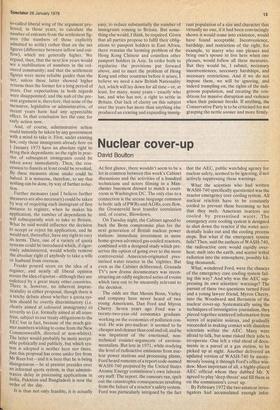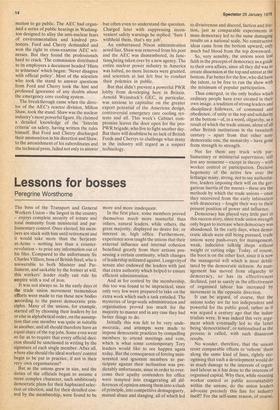Nuclear cover-up
David Boulton
At first glance, there wouldn't seem to be a lot in common between this week's Cabinet discussions and the activities of a hundred technicians and actors filming in a Manchester basement dressed to match a courtroom in Washington DC. The only clue to a connection is the arcane language common to both: talk of PWRs and AGRs, core flow, the Groeneveld heat transfer correlation and, of course, Blowdown.
On Tuesday night, the Cabinet agreed to back the Benn compromise plan for the next generation of British nuclear power stations: immediate investment in more home-grown advanced gas-cooled reactors, combined with a designed study which preserves the option of going over to the more controversial American-originated pressurised water reactor in the 'eighties. But even as the Cabinet deliberated, Granada TV's new drama documentary was reconstructing an oddly neglected series of events which turn out to be uncannily relevant to the decision.
The odds are that Messrs Benn, Varley and company have never heard of two young Americans, Dan Ford and Myron Cherry. Seven years ago Ford was a twenty-two-year-old economics graduate working on the economics of pollution control. He was pro-nuclear: it seemed to be cheaper and cleaner than coal and oil, and he was impatient of the emotional, nontechnical counter-arguments of environmentalists. But late in 1971, while studying the level of radioactive emissions from nuclear power stations and processing plants, Ford heard rumours of a report code-named WASH-740 prepared by the United States Atomic Energy commission's own laboratory staff. The report, the rumours ran, spelt out the catastrophic consequences resulting from the failure of a reactor's safety system. Ford was particularly intrigued by the fact that the AEC, public watchdog agency for nuclear safety, seemed to be ignoring, if not actively suppressing these warnings.
What the scientists who had written WASH-740 specifically questioned was the • reactor emergency core cooling system. All nuclear rental's have to be constantly cooled to prevent them becoming so hot that they melt. American reactors are cooled by pressurised water. The emergency core cooling system is designed to shut down the reactor if the water accidentally leaks out and the cooling process stops. But what if the emergency system fails? Then, said the authors of WASH-740, the radioactive core would rapidly overheat, melt into the earth, and scatter lethal radiation into the atmosphere, possibly killing thousands.
What, wondered Ford, were the chances of the emergency core cooling system failing this way? And why was the AEC suppressing its own scientists' warnings? The pursuit of these two questions turned Ford and a young lawyer friend, Myron Cherry, into the Woodward and Bernstein of the nuclear cover-up. Systematically using the techniques of investigative journalism, they. pieced together scattered information from -scores of selittfate sources, and gradually succeeded in making contact with dissident scientists within the AEC. Many were afraid to talk, but some risked their jobs to co-operate. One left a vital shoal of documents in a parcel at a gas station, to be picked up at night. Another delivered an updated version of WASH-740 by anonymously-tossing it through Ford's office window. Most important of all, a highly-placed AEC official whom they dubbed Mr. X agreed to play 'deep throat' and fill them in on the commission's cover up.
By February 1972 the two amateur investigators had accumulated enough infor mation to go public. The AEC had organised a series of public hearings in Washington designed to allay the anti-nuclear fears of environmentalists and kindred protestors. Ford and Cherry demanded and won the right to cross-examine AEC witnesses. But they found the professionals hard to crack. The commission distributed to its employees a document headed 'Hints to witnesses' which began: 'Never disagree with official policy'. Most of the scientists who took the stand to answer questions from Ford and Cherry took the hint and professed ignorance of any doubts about the emergency core cooling system.
The breakthrough came when the director of the AEC's reactor division, Milton Shaw, took the stand. Shaw was the nuclear industry's most powerful figure. He claimed a detailed knowledge of the 'Interim criteria' on safety, having written the rules himself. But Ford and Cherry discharged their ammunition in his direction and Shaw, to the astonishment of his subordinates and the technical press, failed not only to answer but often even to understand the question. Charged later with suppressing inconvenient safety warnings he replied: 'Sure I withheld them, that's my job'.
An embarrassed Nixon administration acted fast. Shaw was removed from his post and the AEC was dismembered, its functionNbeing taken over by a new agency. The entire nuclear power industry in America was halted, no more licences were granted, and scientists at last felt free to conduct their polemics in public.
But that didn't prevent a powerful PWR lobby from developing here in Britain. Arnold Weinstock's GEC, in particular, was anxious to capitalise on the greater export potential of the American design, controversial emergency care cooling systems and all. This week's Cabinet compromise leaves the door open for the proPWR brigade, who live to fight another day. But there will doubtless be no lack of British Fords and Cherrys to challenge what many in the industry still regard as a suspect technology.



































 Previous page
Previous page